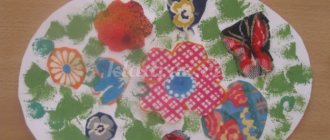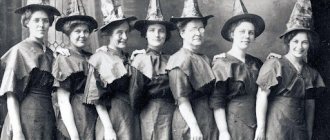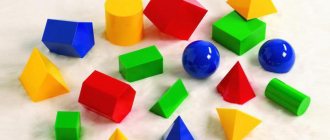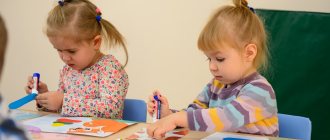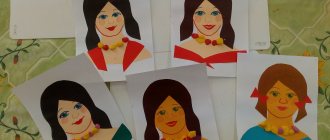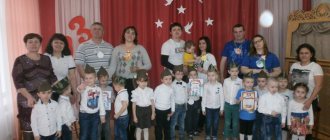How to teach a 5-6 year old child to draw a person: proportions
Teach your child to see the invisible. Before drawing a dressed figure, you need to outline the frame, understand the position of the arms and legs, the direction and rotation of the body relative to the head, etc. Use diagrams; you can always remove extra lines from the drawing with an eraser.
infourok.ru
When a child learns to think in diagrams, he will not have any difficulties when drawing a human figure.
Preschoolers aged 5-6 years can safely explain how the figure of an adult differs from the figure of a child. The module with which we “measure” the figure is the head. A lot depends on how many times the head is “placed” in the diagram of the human figure.
artrecept.com
Show a photo of a child standing next to an adult. Offer to measure (with a ruler, strip of paper, etc.) how many times the child’s head “fits” in his entire figure. Do the same with the adult figure. The child himself will conclude that children have larger heads (relative to the proportions of the whole body).
sovetunion.ru
In adults, the head “fits” 7-8 times (ideally). If you take this into account when drawing a person, the figure will come out proportional and similar.
profymama.com
It is enough to draw a simple diagram several times in order to continue drawing fat and thin people, men, women and children.
Male and female figures are different. These differences can easily be shown in the diagram using geometric shapes. Men have broad shoulders, women have broad hips.
Very soon your child will learn the basics of drawing a person and will be able to portray the whole family!
Lesson summary for the middle group “Human Body”
Zumzum Ibragimova
Lesson summary for the middle group “Human Body”
LESSON SUMMARY
FOR FORMING A COMPLETE PICTURE
PEACE AND HORIZONS EXPANDING
«THE HUMAN BODY!»
Middle group
— formation of children’s ideas about the external features of the structure of the human ;
— introduce the capabilities of the human (I can run, jump, etc.)
;
- develop the ability to consider yourself and each other;
— develop the ability to analyze, compare, and draw conclusions;
Illustrations depicting different people,
IV. Muscles
Understanding muscle structure provides a huge advantage in creating the human body. Therefore, in this section we will look at some structures. And despite the fact that the description will be simplified, it will be sufficient for most drawings. Muscles or prominent bones will be shown as areas of different colors, the black outline being the line of muscle that is visible on the body. In order for you to understand better, the muscles in the examples are clearly expressed. Therefore, remember that this structure is found mainly in athletes, and in ordinary people the muscles are less pronounced. Also remember that women have more graceful and less bulky muscles than men.
Torso
Front view:
- Mastoid muscle;
- Clavicle bones;
- Deltoid;
- Breasts;
- Press.
Back view:
- Deltoid;
- Latissimus dorsi muscles;
- Deltas.
- The neck should not look like a straight cylinder.
- The shoulder line should not be a straight horizontal line.
- The neck narrows towards the bottom
- The transition from the neck to the shoulders is drawn using a trapezoidal shape.
Hands
Its position itself plays a large role in the behavior of the muscles on the arm, so I propose to consider different types. Notice how the muscles show up in different situations.
Straight arm, bent palm (inner side)
- Flexor carpi radialis;
- Extensor carpi radialis;
- Elbow \"peak\";
- Pronator teres;
- Line of transition to the body.
Relaxed (outer side)
- Deltas;
- Biceps;
- Triceps;
- Extensors.
Bent (outside)
Biceps
- Gains volume if there is resistance, for example if the hand is holding something heavy, and the triceps;
- Gains volume if the hand makes an effort to straighten something;
- The forearm starts out large and partially tapers.
Notice the alternation of the changing line of the hand.
- When a person stands, his arms do not hang straight. Pay attention to the connection between the line of the arm and the back of the neck.
- Consider how your hand changes when you turn your palm.
Legs
- Vastus medialis;
- Rectus femoris muscle;
- Sartorius;
- Patella;
- Calf muscles;
- tibialis anterior muscle;
- Anterior muscle;
- Extensor digitorum longus;
- Adductor;
- Semitendinosus muscle;
- Achilles tendon;
- Ankle bones;
- Biceps.
Bent leg
- The biceps is clearly visible with the leg bent (inside);
- When transferring weight to the leg, the rectus femoris muscle increases (inner side);
- When the leg is tensed on the inside, the tibialis anterior muscle is tensed, and when the leg is tensed on the outside, the calf muscles are tensed;
- When no force is applied to the leg, it is in a relaxed state and, accordingly, the muscle line is smooth (outer side).
When the leg stands straight, the bottom of the leg bends backward (side view) and outward (straight view).
VI. Body in profile
Drawing a silhouette in profile starts with the usual skeletal structure:
1. The shoulder joints are a little distant from the spine and are not at the same level with it, because the “line” of the shoulders is in the form of an arc.
View from above:
Shoulder joint
Spine center
2. The center of gravity of the body is below the navel, inside the body. The body is most balanced when this point is on the balance line.
3. The hip joint is connected to the knee ankle line at a slight angle, so that the knees correspond to the center of gravity. If you look at the silhouette of the skeletal structure, there is an arc running from the head to the feet. However, such an arch is observed in upright people, and nowadays many people slouch.
4. The spine has a curved shape, similar to the letter “S”. How strong this curve is varies from person to person.
5. The apex of the curve of the spine, which protrudes forward, is located between the shoulder blades.
6. There is the opposite apex of the curve of the spine, which protrudes inward and is located slightly above the pelvic bone.
Having outlined the chest and pelvic bones, you can create an individual figure by superimposing lines of different sizes.
1. The arch of the back in women is more arched and more flexible than in men.
2. Women's abdomen most often has a smooth curve, while men tend to be flat.
3. Likewise, women's buttocks are rounded while men's are flatter.
VII. Breasts
To draw breasts, mark the nipples inside the body outline and then add volume.
To draw the breast from the side, draw a circle centered on a horizontal line that represents the level of the nipple.
- Here you can show the volume with a small line.
- The lower half of the circle corresponds to the lower part of the chest. The upper part of the breast is drawn with a slight curve extending from the nipple to the neck.
The shape of the breast begins at the axillary curve. It either sticks out (large breast size) or has a small depression (small breast size).
In this picture
You can clearly see the connection between the chest and biceps. The curve of the armpit goes into the chest, although most often part of this line is not drawn (indicated by a dotted line).
Preview:
"Parts of the body and face"
Class . There are such boys (Drawing with a simple pencil)
Program content. Teach children to draw a happy and sad face with a simple pencil. Learn to analyze and understand the content of a poem. Cultivate a friendly attitude towards others. Learn to express and describe your feelings.
Material. Landscape sheets, simple pencils (for each child).
Read excerpts from A. Barto’s poem “There are such boys” to the children:
We look at the boy - He’s kind of unsociable! He frowns and sulks, as if he drank vinegar. We thought and thought, We thought and came up with: We will be, like Vovochka, Gloomy, gloomy. We went out into the street - They also began to frown. He looked at our faces, He was about to get angry, Suddenly he burst out laughing. He doesn't want to, but he laughs louder than a bell.
Ask the children:
– What was the boy like at the beginning of the poem? (Gloomy, angry, sad.)
– What did he become at the end of the poem? (Cheerful, kind, laughing.)
Invite the children to portray first a sad boy, and then a cheerful one. To do this, you need to draw a circle on the left half of the sheet - a face, eyebrows in the form of downward arches and a mouth, with the corners of the lips downward. On the right side of the sheet you need to draw a circle - a face, straight eyebrows and a smiling mouth with the corners of the lips raised up.
At the end of the lesson, ask the children when they feel sad and when they feel happy.
Source
How to draw a person in motion
Middle school students know a lot about the rules for placing an object in space, taking into account perspective. For students in grades 5–7, it is advisable to start a drawing lesson with an analysis of the structure of the human figure. This is necessary in order to correctly convey the proportions in the drawing, to professionally depict parts of the body, otherwise the real person in the picture will resemble a mannequin. Despite the fact that the anatomy of the human body is studied later, at this age children already have an understanding of the skeleton, muscles and joints. View changes (opens in a new tab)
The first step in building a sketch step by step is determining the proportions. In adults, the length of the body from the top of the head to the hips is usually equal to the length of the legs. The height of the head fits into the distance from the chin to the beginning of the thigh approximately 3 times. This figure is lower in children and adolescents. The length of the legs of a harmoniously built person is equal to the height of the head multiplied by 3.5–4.
You can depict a person depending on the angle or location of the object and the artist. The main positions are in full face, when the sitter is facing the viewer, in profile - when the person depicted is located from the side, half-turned or half-front, in which the face is not completely visible.
Step 1
The pencil drawing begins with a sketch of the head and torso in the foreground.
The spine is the basis of the entire figure; it can be outlined with a curved line. The large joints of the shoulders and pelvis are schematically depicted as circles. The sketch lines are drawn easily, without pressure.
Step 2
At the next stage, the upper and lower limbs are drawn. The elbows are located at waist level, the length of the humerus is equal to the length of the ulna, the knees are in the middle of the leg. The more accurate the sketch, the better the movement will be conveyed.
Step 3
Now you need to build muscle. The most voluminous part of the forearm, thigh and lower leg is located in the upper third; closer to the joint, the limbs gradually narrow. It is easier to depict the body in the form of two ovals.
Step 4
Particular attention is paid to the hands and feet. They are also depicted schematically, imitating the skeleton of the limbs. The foot should be longer than the hand.
Step 5
After drawing all parts of the figure, the extra lines are erased. The silhouette is given the necessary outlines: sharp corners are smoothed out, the sides become sloping, body parts are connected by curved lines.
Step 6
When depicting a face, you also need to maintain proportions. The height of the forehead is equal to the distance from the eyebrow line to the tip of the nose and from the tip of the nose to the chin. The distance between the eyes is equal to the length of the eye. The ear is depicted just below the eyebrow line. To make a girl smile, the corners of her lips need to be slightly raised. At this stage, you can sketch the hairstyle.
Step 7
The more details there are in the drawing, the more realistic it will be. You need to draw clothes, shoes, accessories and other elements that create a bright image. Strands of hair can be highlighted with separate lines.
Step 8
You can color the drawing using colored pencils or paints.

